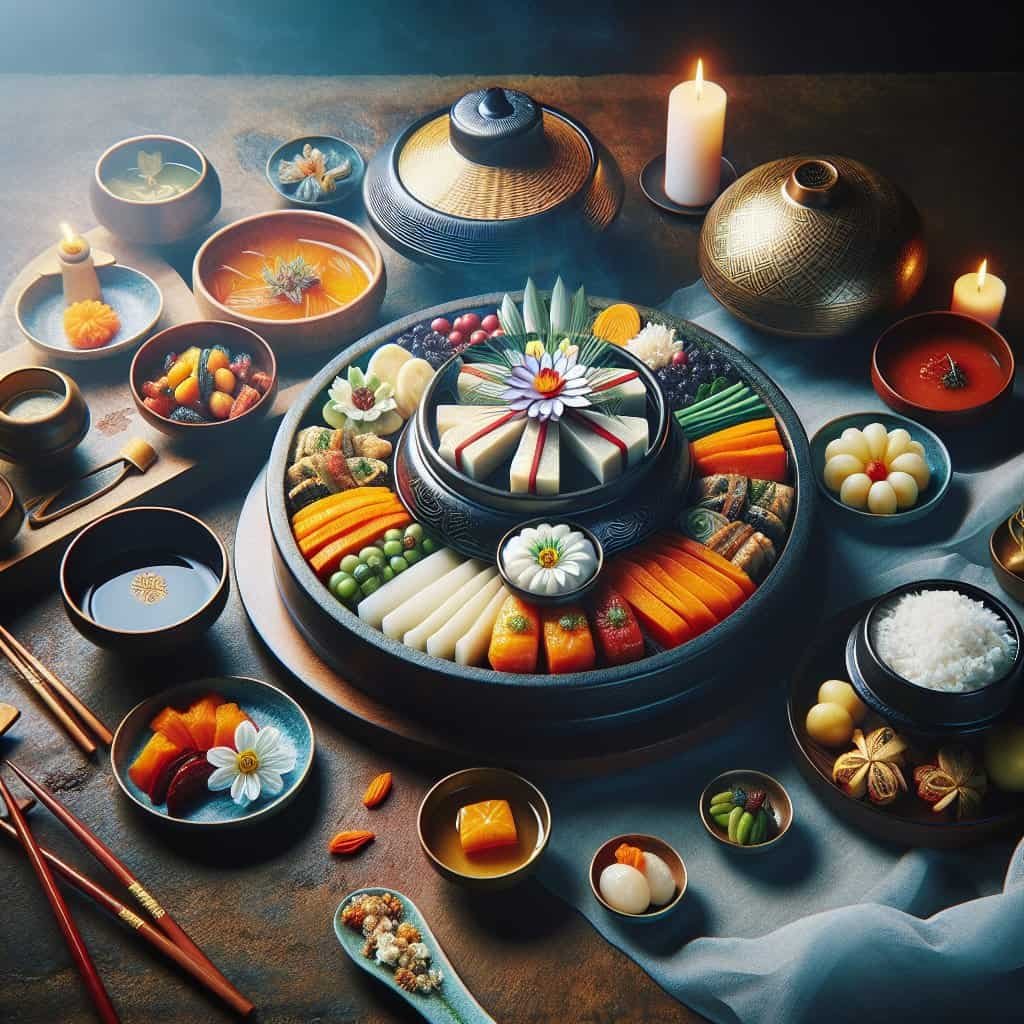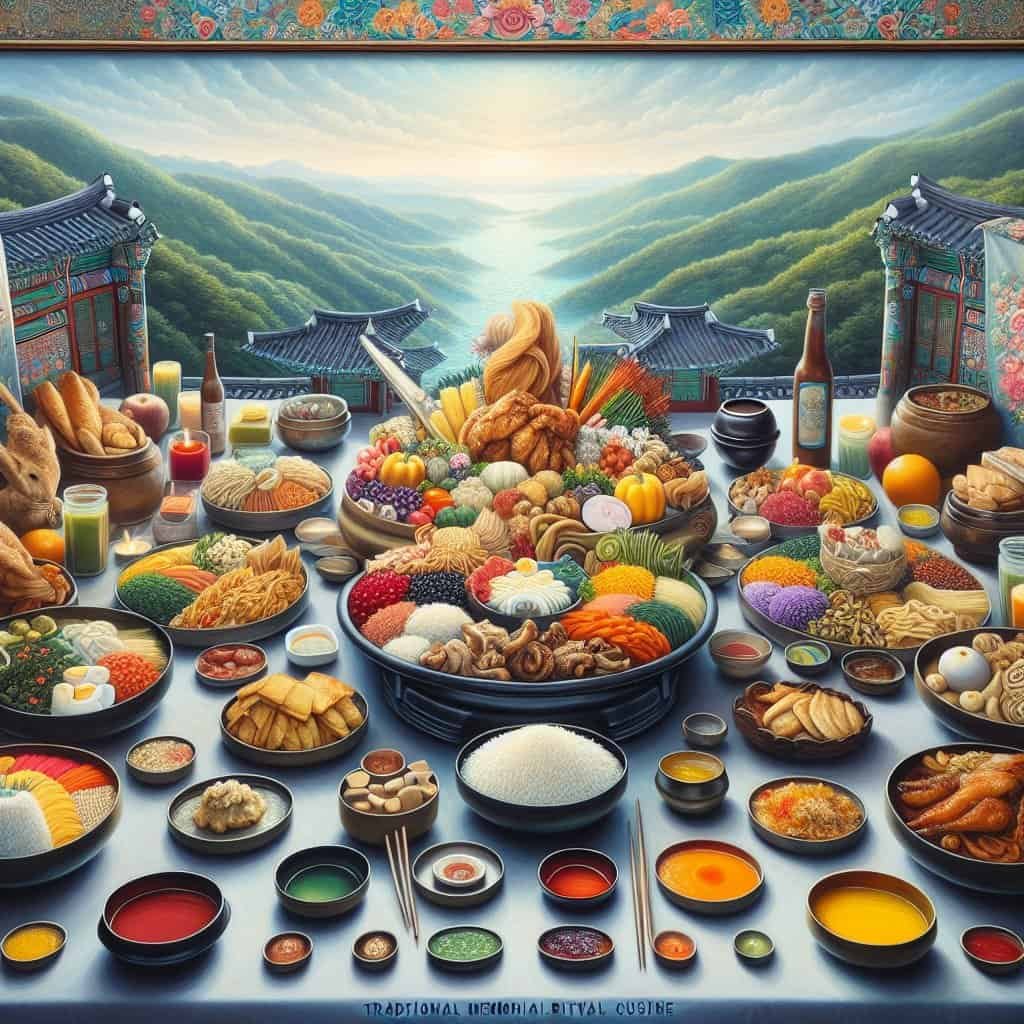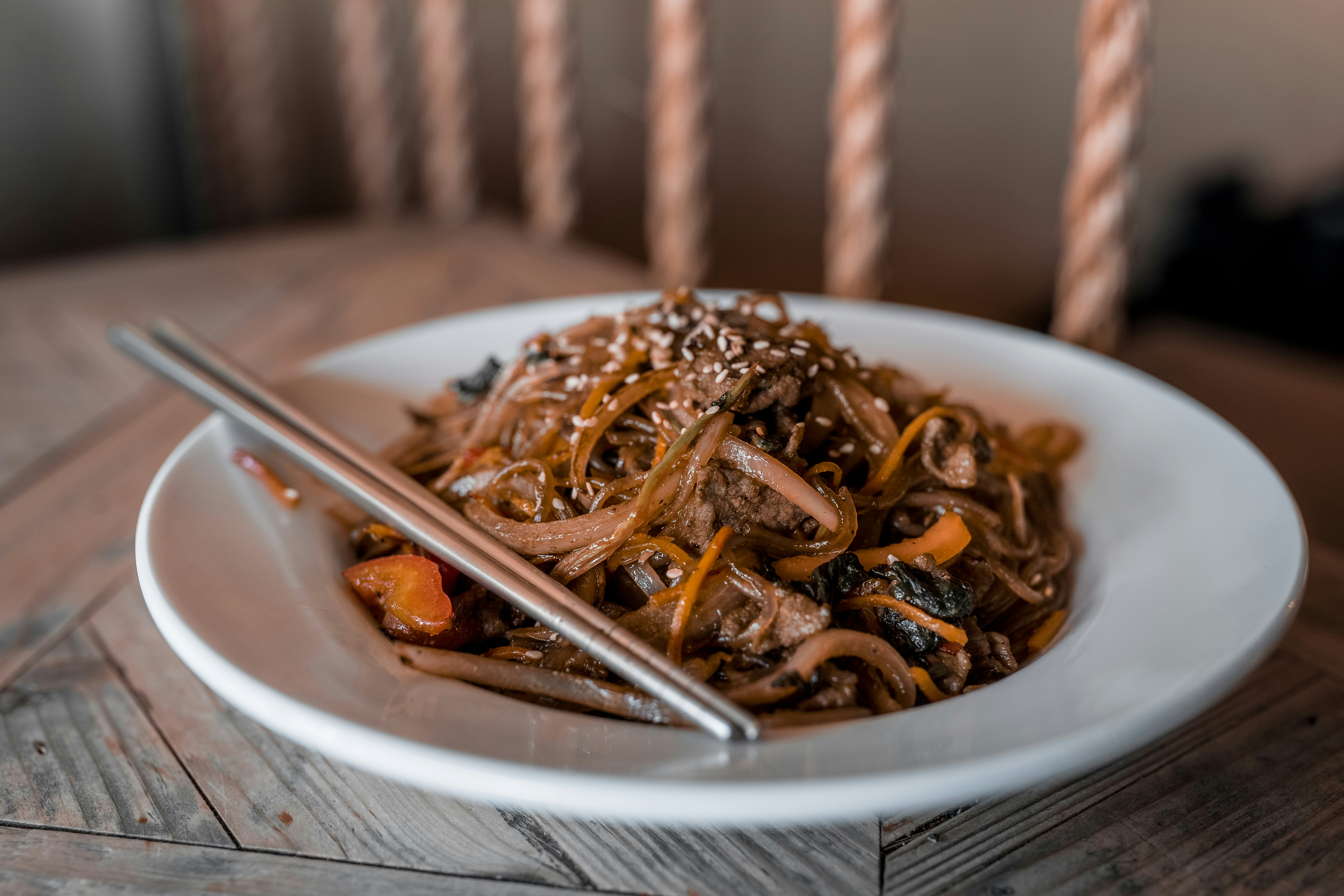Imagine yourself transported to the vibrant and diverse world of traditional Korean memorial ritual cuisine. A feast for both the senses and the soul, these elaborate meals hold deep cultural significance in Korean society. From the carefully selected ingredients to the precise preparation techniques, each dish is meticulously crafted to honor and remember ancestors. Through this article, you will discover the rich history and meaning behind this ancient tradition, gaining a deeper understanding of the unique cultural tapestry that is woven into every bite.

History of Korean Memorial Rituals
Origins of memorial rituals
Korean memorial rituals have a rich history that dates back centuries. The tradition of honoring ancestors and commemorating the deceased has been an integral part of Korean culture for generations. The origins of these rituals can be traced back to ancient shamanistic beliefs, where it was believed that the spirits of ancestors played a significant role in the lives of their descendants. Memorial rituals were thus performed to pay respects to these ancestors and seek their blessings and guidance.
Evolution of memorial rituals over time
Over time, Korean memorial rituals evolved and incorporated various cultural influences. As the country experienced periods of Buddhism, Confucianism, and other religions, the rituals began to incorporate elements from these belief systems. For example, Confucian teachings emphasized the importance of filial piety and ancestor veneration, which further solidified the practice of memorial rituals in Korean society. With each passing era, these rituals underwent changes in terms of rituals, customs, and the overall significance in society.
Components of Traditional Korean Memorial Ritual Cuisine
Rice
Rice holds immense significance in Korean memorial rituals and is considered the soul of the meal. It symbolizes sustenance and the foundation of life. In memorial rituals, rice is often prepared in the form of rice cakes or steamed white rice. It is meticulously cooked and shaped into various symbolic forms, representing blessings and good fortune for both the living and the deceased.
Soup
Soup, known as guk in Korean, is another essential component of traditional memorial ritual cuisine. It is believed to balance the flavors of other dishes and provide comfort to the spirits of ancestors. Commonly served soups include miyeokguk (seaweed soup) and doenjangguk (soybean paste soup). These soups are often prepared with seasonal ingredients and are thought to cleanse and rejuvenate the body and soul.
Meats and Fish
Meats and fish are integral parts of Korean memorial ritual cuisine, symbolizing prosperity and abundance. Pork, beef, and chicken are commonly used, along with various types of fish such as mackerel and cod. These protein-rich dishes represent the rewards of hard work and the blessings bestowed upon the family by their ancestors. They are often prepared using traditional cooking techniques, such as grilling and braising, to enhance their flavor and texture.
Pickled Vegetables
Pickled vegetables, or kimchi, are a staple in Korean cuisine, including memorial ritual meals. Kimchi represents the preservation of tradition and the connection between the past and present. The fermentation process used to make kimchi imparts a unique flavor and texture, and it is believed to have numerous health benefits. Different types of kimchi, such as cabbage, radish, and cucumber, are served to add a tangy and vibrant element to the meal.
Fruit and Sweets
Fruit and sweets serve as the culmination of a memorial ritual meal, offering a sweet ending to the dining experience. Fruits such as persimmons, apples, and pears are commonly served, symbolizing longevity and good fortune. Traditional Korean sweets, known as hangwa, are also included in these meals. Hangwa are delicate and intricately designed confections made from rice flour, honey, nuts, and various dried fruits. Their vibrant colors and intricate shapes add a touch of elegance to the memorial ritual cuisine.
Symbolism and Meaning in Memorial Ritual Cuisine
Honoring ancestors
One of the primary purposes of Korean memorial ritual cuisine is to honor and pay respect to ancestors. The ingredients used, the meticulous preparation, and the overall presentation of the dishes are all done with the intention of showing gratitude and reverence towards those who came before. By preparing and serving their favorite foods, it is believed that the spirits of ancestors can be nourished and comforted.
Communication with the deceased
Memorial ritual cuisine serves as a form of communication between the living and the deceased. It is believed that the spirits of ancestors can partake in the scent and essence of the food offered to them. This act of offering sustenance is seen as a means of maintaining a connection and ensuring that the spirits are not forgotten. In Korean culture, it is believed that the deceased continue to play a role in the lives of their descendants, and memorial ritual cuisine is a way to acknowledge and maintain that relationship.
Symbolic representations
Each component of Korean memorial ritual cuisine carries its own symbolic meaning. Rice represents abundance and sustenance, soup represents comfort and cleansing, meats and fish symbolize prosperity, and pickled vegetables represent tradition and preservation. From the choice of ingredients to the cooking techniques and presentation, every aspect of memorial ritual cuisine is carefully chosen and thoughtfully prepared to convey meaningful messages to both the living and the deceased.
Preparation and Presentation of Memorial Ritual Cuisine
Special cooking techniques
The preparation of memorial ritual cuisine involves special cooking techniques that have been passed down through generations. These techniques not only enhance the flavors and textures of the dishes but also allow for the preservation of tradition. Grilling, braising, fermenting, and steaming are some of the commonly used techniques that add depth and richness to the dishes. The meticulous attention to detail in cooking ensures that every dish is prepared with love and respect.
Decorative table settings
The presentation of memorial ritual cuisine is just as important as the preparation. When serving a memorial ritual meal, a table setting known as jesa is carefully arranged. The table is adorned with a variety of dishes, each placed in a specific order and position, symbolizing various aspects of the ritual. White tablecloths, elegant tableware, and intricate decorations are used to create an atmosphere of reverence and respect. The overall presentation adds to the aesthetic appeal and aligns with the cultural significance of the memorial ritual.
Regional Variations in Memorial Ritual Cuisine
Different customs across Korea
Korea’s diverse regional culture and geography have led to variations in memorial ritual cuisine across the country. Different regions have their own customs and traditions when it comes to preparing and serving these meals. For example, in the southern region, spicy and flavorful dishes are favored, while the northern region leans towards milder and simpler flavors. These regional differences add depth and diversity to Korean memorial ritual cuisine, showcasing the rich cultural heritage of the country as a whole.
Distinct local ingredients and flavors
Regional variations in memorial ritual cuisine are also influenced by the availability of local ingredients. Each region boasts unique specialties and flavors that contribute to the overall culinary experience. For instance, coastal areas may incorporate more seafood into their memorial ritual cuisine, while mountainous regions may focus on wild greens and herbs. These distinct flavors and ingredients enrich the cultural tapestry of Korean memorial ritual cuisine and reflect the local heritage.
Cultural Significance of Memorial Ritual Cuisine
Preservation of cultural heritage
Memorial ritual cuisine plays a vital role in preserving the cultural heritage of Korea. The traditions, customs, and recipes associated with these rituals have been passed down from generation to generation, ensuring that the country’s rich culinary history remains intact. By continuing to practice and celebrate memorial rituals, Koreans keep their cultural identity alive and honor the traditions of their ancestors.
Strengthening family bonds
Korean memorial ritual cuisine serves as a means to strengthen family bonds and reinforce the importance of kinship. The preparation of these meals often involves the whole family, and each member has a role to play in bringing the feast to fruition. Through the shared experience of cooking and dining together, family members can connect with their roots, share stories about their ancestors, and create lasting memories.
Passing down traditions to future generations
Memorial ritual cuisine is a way to pass down traditions and values to future generations. As children participate in the preparation and consumption of these meals, they become immersed in the cultural practices and gain a deeper understanding of their heritage. By instilling a sense of appreciation for their ancestors and the significance of memorial rituals, these traditions are safeguarded and carried forward into the future.

Role of Memorial Ritual Cuisine in Korean Society
Traditional vs. modern memorial rituals
In modern Korean society, there is a balance between traditional and modern memorial rituals. While some families adhere strictly to age-old customs, others choose to incorporate a more contemporary approach. Traditional memorial ritual cuisine is still widely practiced, especially during major ancestral holidays, such as Chuseok and Seollal. However, as lifestyles change and society evolves, there is also room for flexibility and adaptation in the way these rituals are carried out.
Celebrating special occasions
Memorial ritual cuisine extends beyond the commemoration of the deceased and can be seen as a way to celebrate special occasions. Birthdays, weddings, and anniversaries are all significant moments in a person’s life, and memorial rituals can be performed to honor these milestones. By incorporating traditional memorial ritual cuisine into these celebrations, Koreans maintain a sense of connection to their ancestors while celebrating the joyous moments of life.
Serving as a form of respect and etiquette
In Korean society, memorial ritual cuisine holds great importance in terms of respect and etiquette. When paying visits to ancestral graves or participating in memorial services, it is customary to bring food and make offerings to the deceased. These offerings are seen as a gesture of respect and an acknowledgment of the deceased’s continued presence in the lives of their descendants. By participating in these rituals, Koreans uphold societal norms and demonstrate their reverence for family and ancestral ties.
Influence of Memorial Ritual Cuisine on Korean Gastronomy
Impact on Korean cuisine
Memorial ritual cuisine has had a significant impact on Korean gastronomy as a whole. The recipes, cooking techniques, and flavor profiles associated with these rituals have influenced the broader spectrum of Korean cuisine. Many dishes that were once reserved for memorial rituals have now become popular in everyday meals. For example, kimchi, which was traditionally a staple in memorial ritual cuisine, is now a beloved side dish consumed on a regular basis. The rich heritage of memorial ritual cuisine has left an indelible mark on Korean gastronomy.
Integration of memorial ritual dishes into everyday meals
As memorial ritual cuisine continues to evolve, there is a growing trend of integrating these dishes into everyday meals. Traditional memorial ritual dishes are now being served in restaurants and enjoyed by Koreans and foreigners alike. The flavors and techniques once reserved for special occasions are now finding their way into the homes and hearts of people worldwide. This integration not only showcases the versatility of memorial ritual cuisine but also ensures its continued relevance in contemporary Korean society.

Celebrating Life and Death Through Memorial Ritual Cuisine
Embracing the cycle of life and death
Korean memorial ritual cuisine allows individuals to embrace the cycle of life and death. It serves as a reminder that life is finite and should be celebrated and cherished. By commemorating the deceased and honoring their memory through food, Koreans acknowledge the impermanence of life while finding solace and meaning in the act of preparing and sharing a meal.
Uniting the living and deceased through food
Memorial ritual cuisine acts as a bridge between the living and the deceased, bringing them together through food. It is believed that by offering food to their ancestors, Koreans can maintain a connection and ensure that their spirits are at peace. The act of partaking in the same meal has a unifying effect, transcending time and bringing together generations in a shared experience.
Preserving Traditional Korean Memorial Ritual Cuisine
Efforts to safeguard heritage
In recent years, there have been concerted efforts to safeguard the heritage of traditional Korean memorial ritual cuisine. Various organizations, cultural institutions, and government bodies are working together to document and preserve the recipes, customs, and techniques associated with these rituals. Through educational programs, research, and awareness campaigns, the aim is to ensure that these valuable traditions are not lost to time.
Educational initiatives and cultural events
Educational initiatives and cultural events play a crucial role in preserving traditional Korean memorial ritual cuisine. Cooking classes, workshops, and demonstrations are organized to teach younger generations about the significance and techniques of memorial ritual cuisine. Cultural festivals and exhibitions provide a platform to showcase and celebrate these culinary traditions, allowing people from all walks of life to experience and appreciate the cultural significance of these age-old practices.
In conclusion, traditional Korean memorial ritual cuisine holds tremendous cultural significance and plays a vital role in preserving the country’s rich heritage. From its origins rooted in ancient beliefs to its evolving practices and regional variations, memorial ritual cuisine represents a cultural connection between the living and the deceased. Through careful preparation, symbolic representations, and the passing down of traditions, Koreans celebrate life, honor their ancestors, and ensure the preservation of their cultural identity for future generations to cherish.


